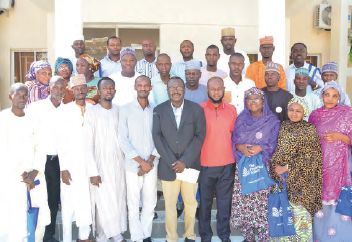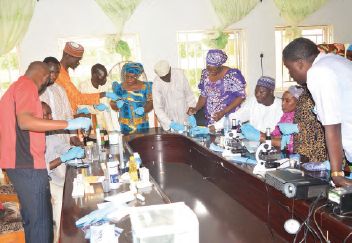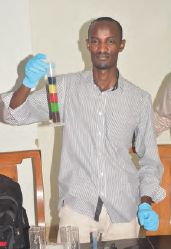
Physiology News Magazine
‘Teach the Teachers’ – a workshop on Bioscience approaches in the Nigerian classroom
Membership
‘Teach the Teachers’ – a workshop on Bioscience approaches in the Nigerian classroom
Membership
M B Maina
School of Life Sciences, University of Sussex, UK
M S Muhammad
College of Medical Sciences, Gombe State University, Nigeria
Mohammed Buba
College of Medical Sciences, University of Maiduguri, Nigeria
https://doi.org/10.36866/pn.102.40

The importance of science in promoting international development cannot be overemphasised. However, in Africa, cultural and religious misconceptions about science strongly restrict the extent to which science is appreciated, partly contributing to hampering science development on the continent. In Nigeria for instance – Africa’s most populous nation – science literacy has been estimated as below 10%. In most schools, science teaching is too often based on outdated models that are long known to be ineffective. Additionally, science teachers rarely employ innovative teaching approaches, and, as a result, many students never develop a passion for science. These collectively contribute to low student enrolment in sciences and the generation of poorly qualified teachers and scientists, which additionally contributes to low science awareness and thus poor science policies.
To begin to tackle these problems; with support from The Physiological Society, we organised the first hands-on ‘Teach the Teachers’ workshop on bioscience approaches in the Nigerian classroom, targeting science teachers. This was aimed at reinvigorating their passion for science, thereby help in creating a sustainable system where students would continue to get excited by their teachers about science. To this end, at least two science teachers were invited from nine primary and secondary schools to participate in a one-day hands-on science workshop on running simple and enjoyable experiments for a low-cost setting that can be adopted to the classroom. To enable teachers fully to benefit from the workshop, the activities were run in three sessions, covering chemical interactions, cells and system physiology, and electrophysiology, which are all partly contained in their school curriculum.
The first session kicked off with experiments on how to create density columns and a rainbow reaction tube. After demonstrations, teachers were tasked with creating density columns and reaction tubes using varying components (e.g. low and high salt and sugar concentrations for the columns). This greatly stimulated and made them engage in brainstorming sessions, especially on how manipulating components, like sodium carbonate concentration or vinegar, could produce an ideal rainbow reaction tube (pictured right).

Many science teachers lack basic microscopy skills, such as how to prepare microscope slides. Consequently, many students end up knowing little about the use of microscopic techniques in bioscience. Therefore, in the second session of the workshop, experiments on how to make slides for microscopy from cheek and blood cells were demonstrated. Participants were tasked with making their slides, with or without methylene blue. This enabled teachers to learn not only about the preparation procedure but how stains with affinity to different cellular compartments (e.g. the nucleus) can practically be used in the identification of cells. They were further shown various tissues (e.g. Testis) under the microscope using already prepared slides. This session stimulated many thought-provoking questions and discussion on cellular changes in diseases like Alzheimer’s.
Backyard Brains Electromyography (EMG) Spikerboxes were used in the last session to introduce teachers to basic electrophysiology. Considering that the experiment was designed to focus on muscle electrical activity, teachers first received a basic lecture on brain-muscle relationship, followed by demonstrations on how to measure muscle activity. This session tremendously stimulated the science teachers, especially, the realisation that fatigue could lower muscle potentials. Participants divided into groups were allowed to measure the EMG of their colleagues. Many teachers were thrilled with the experience and wished that the workshop be run more frequently. In the end, reagent leftovers and manuals for running other simple and fun experiments were donated to the teachers. They also received leaflets, pens and other freebies on neurosciences and molecular sciences.
To ascertain the impact of these activities, we administered questionnaires to the participants and also observed their enthusiasm during the hands-on activities. All the teachers confessed that the outreach introduced them to simple approaches of designing simple science experiments that they now intend to use in connecting theoretical teaching with practicals in their classroom. For instance, a teacher said, ‘learning how to measure EMG was the most important part of the workshop for me, I will introduce it to my students’. The feedbacks from the events were overall overwhelmingly positive.
The events demonstrated to participants that science can be taught in a fun and simple way. We received many messages of appreciation from the participants and their schools, confirming that the activities were helpful. The event was covered and published by the local media. Thus, we are hopeful that its success would increase the awareness and perception of science by the public, increase students passion for science, motivate similar activities by local scientists and encourage the government to consider a regular curricular review to accommodate modern classroom science methods.

